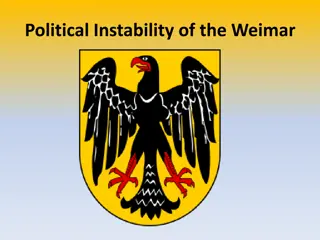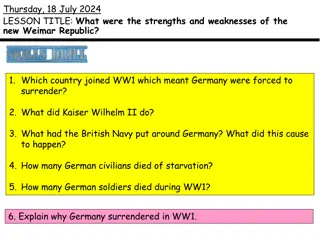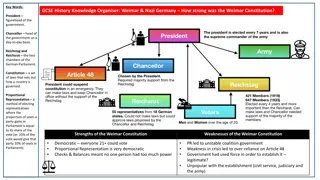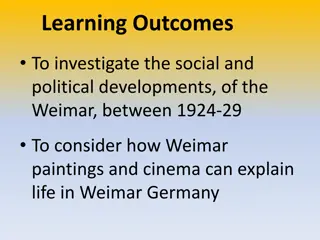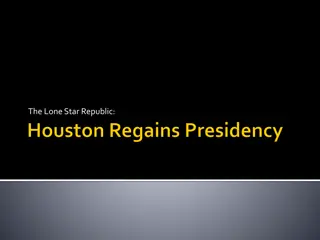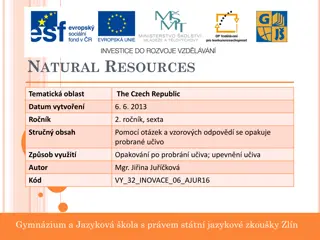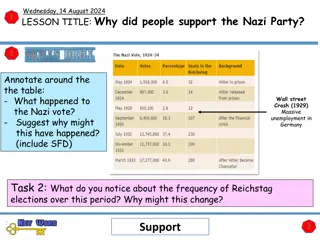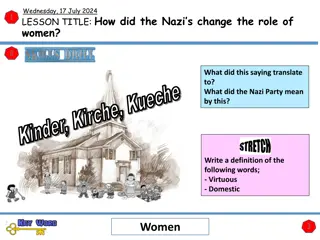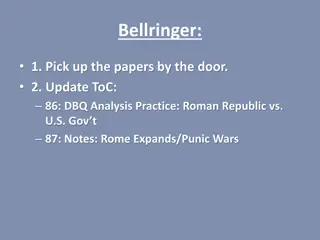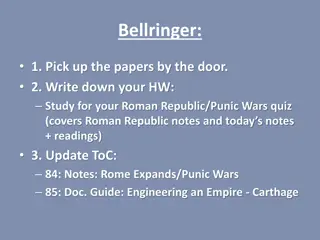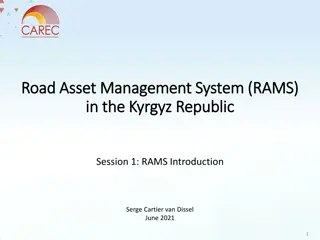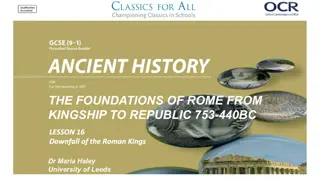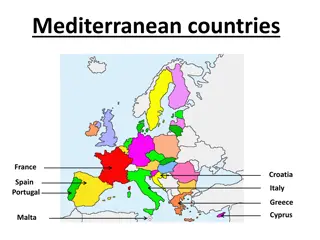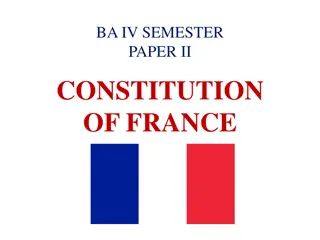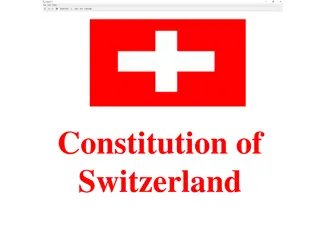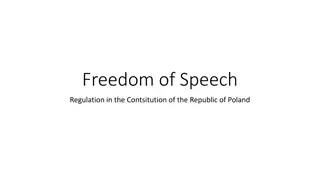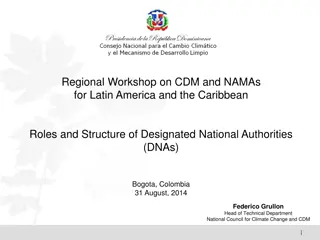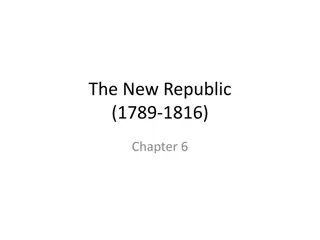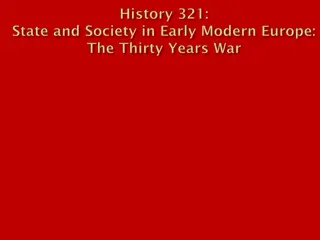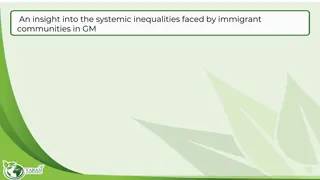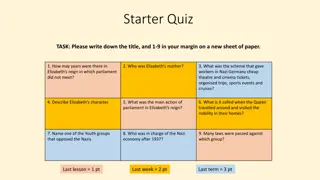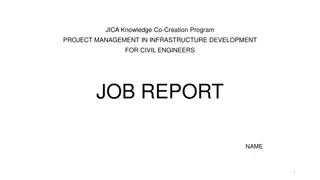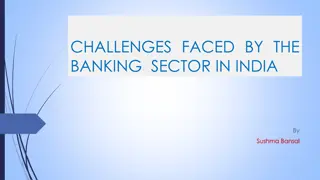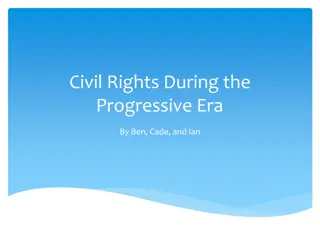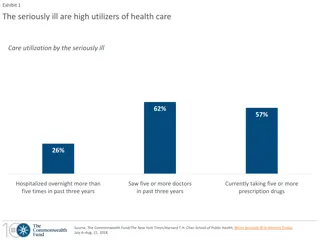Understanding the Challenges Faced by the Weimar Republic
This compilation of sources delves into the various problems encountered by the Weimar Republic, such as food shortages, political uprisings, economic instability, and currency devaluation. It discusses the threats from both the Left and the Right, shedding light on the turmoil and crises faced by the German government during the Weimar era.
Download Presentation

Please find below an Image/Link to download the presentation.
The content on the website is provided AS IS for your information and personal use only. It may not be sold, licensed, or shared on other websites without obtaining consent from the author. Download presentation by click this link. If you encounter any issues during the download, it is possible that the publisher has removed the file from their server.
E N D
Presentation Transcript
WARNING! Remember these answers are not full answers but are just suggestions of points that you could include!
How far does this source explain the problems faced by the Weimar Republic? Explain what the source does show Explain what the source doesn t show- use your own knowledge Write about the tone, language or provenance of the source Who wrote it and why? Are they biased in some way? How can you tell? Sum up your final answer
(In source) At the end of the war there was a severe shortage of food. The German people were surviving on turnips and bread and even the flour used to make the bread was mixed with sawdust. Not only that the price of goods was rising due to shortages. The left-wing Communist group were known as the Spartacists. They were much like the Bolsheviks who had just taken control in Russia. They wanted Germany to be ruled by worker s councils or soviets. Bitter street fighting followed resulting in a victory for the Freikorps who had an agreement with Ebert to put the rebellion down. (Not in source) Weimar faced threats from the Right. These were largely people who had grown up in the successful days of the Kaiser and liked all that Germany stood for at that time. A group of them, led by Kapp, brought about a rebellion in Berlin which seriously threatened the government.
Why was this cartoon published in 1923? (7) What is the main message ? The artist of the cartoon wants me to think Why was the source published? I think the cartoon was published because What was happening at the time to explain why the source was published? I know at this time
The artist of the cartoon wants me to be aware of the failings of the Weimar Republic. I think the cartoon was published because people needed bread as they were starving, but could not afford it because money was worthless. French and Belgium troops had entered the industrial area of the Ruhr. The German workers went on strike but still needed paying. As Germany was not producing any goods it had nothing to trade with. The government printed more paper money. The money became worthless. So the cartoon is highlighting this problem. I know that at this time the crisis came to a head in 1923 with the French and Belgian invasion of the Ruhr.
Are you surprised by this source? (7) Yes I am surprised- explained using content/ context or both. No I am not surprised- explained using content/ context or both. Explain who has produced the source and whether that makes you surprised or not. A poster published in Germany in 1923. The woman represents France. The words at the bottom say, Hands off the Ruhr!
I am not surprised by this poster because the French invaded the Ruhr when Germany did not keep up with reparation payments. This was an illegal action by France and very unpopular in Germany because the Ruhr was Germany's most important industrial area. The Germans started a policy of passive resistance and this poster is part of that policy and therefore I am not surprised by it.
4 mark questions Describe the events which led to Germany becoming the Weimar Republic. What were the main features of the Weimar constitution? Describe the Spartacist uprising of January 1919. Describe 2 early threats to the Weimar Republic. Describe the Kapp Putsch of 1920.
6 mark questions Explain why Germany suffered from hyperinflation in 1923. Explain why the Weimar Republic was under threat in the period up to the end of 1923. Explain why the Weimar Republic faced an economic crisis in 1923. Explain why 1923 was a difficult year for the Weimar Republic.
10 mark questions How far had Germany recovered from its problems by 1929? Explain your answer. How successful was the Weimar Republic in dealing with Germany s problems between 1923 and 1929? Explain your answer. To what extent did the Weimar Republic recover in the period 1923-1929? Explain your answer. The Weimar Republic was a failure in the years after 1923. How far do you agree with this statement? Explain your answer
Describe the events which led to Germany becoming the Weimar Republic. They lost the war. The Allies offered Germany peace with one of the conditions being that it should become more democratic. The Kaiser refused resulting in sailors in Kiel revolting. On 9 November 1918 the Kaiser abdicated. The following day Ebert announced that the new Republic was in existence.
What were the main features of the Weimar constitution? It was a democracy. Everyone 20 and over could vote. (Includes women) Election results decided by proportional representation. The chancellor was head of government. A president, elected every seven years, was head of state. The president had emergency power to dissolve the Reichstag and rule himself. Proportional representation made it unlikely that any party would have overall control, resulting in coalition governments. They voted for the President who appointed the Chancellor.
Describe the Spartacist uprising of January 1919. It was an uprising by the left-wing group led by Liebknecht and Luxemburg. They wanted a Germany ruled by workers councils or soviets. They made a bid for power in early 1919. There was bitter street-fighting between Spartacists and Freikorps, with casualties high. The Freikorps won and the Spartacist leaders were murdered.
Describe the Kapp Putsch of 1920 A group of Freikorps, led by Kapp, attempted to take power in Berlin. The government fled from the city. Kapp set himself up as head of a new government. His aim was to recover land taken by the Treaty of Versailles. The army refused to stop Kapp. The putsch was defeated by the people of Berlin. Workers went on strike and Berlin ground to a halt. Kapp fled to Sweden.
Explain why Germany suffered from hyperinflation in 1923. The situation had come about from 1921. Large quantities of goods were sent to Belgium and France. As a result there were not enough goods in Germany and so prices rose making inflation worse. The Treaty of Versailles said that Germany had to pay reparations. These were later fixed at a very high figure putting an extra burden on the German economy that was being rebuilt after the war. As it had no goods to trade the government simply printed more money. The government and the great industrialists were able to pay off their war debts in worthless money. This set of a chain reaction. Prices and wages rocketed.
Explain why the Weimar Republic faced an economic crisis in 1923. Germany delayed paying reparations and French and Belgian troops occupied the important industrial area of the Ruhr. The German workers were ordered to go on strike and the government printed money to pay them. They had no money as goods were not produced and were not being sold. The longer the problem continued the more money was printed until it became worthless.
Explain why the Weimar Republic was under threat in the period up to the end of 1923. The Republic was facing a threat from the left- wing group known as the Spartacists. The signing of the treaty of Versailles caused a problem. There was fierce opposition from the right, when Kapp attempted a putsch. In 1923, France and Belgium invaded the Ruhr. In 1923 Germany suffered from hyperinflation. In 1923 Hitler believed the time was right to attempt the Munich Putsch.
Explain why 1923 was a difficult year for the Weimar Republic. There was an occupation of the Ruhr. There was hyperinflation. There was the Munich Putsch.
To what extent did the Weimar Republic recover in the period 1923- 1929? Explain your answer. Hyperinflation was ended and confidence returned with the introduction of a new currency and reduction in government spending. Between 1924 and 1929 Germany received over 25 billion marks in loans from the USA under the Dawes Plan. With this German industry was re-built thus raising the standard of living. Some argued that the new ideas of culture and art were unpatriotic and they wanted to celebrate traditional values. They argued this new phase meant that Germany was going into moral decline.
How successful was the Weimar Republic in dealing with Germany s problems between 1923 and 1929? He negotiated the Dawes Plan which gave a loan of 800m, reduced annual reparations and gave longer to pay. Between 1924 and 1929 Germany received over 25 billion marks in loans. With this German industry was re- built. Stresemann ended hyperinflation and brought confidence back by introducing a new currency and reducing government spending. Germany s international position was improved. By the 1925 Locarno Pact Germany s borders were resolved and Germany was admitted to the League of Nations in 1926. The greater freedom of the republic encouraged a cultural rival through artists, writers, architects and musicians. Some argued that the new ideas of culture and art were unpatriotic and they wanted more traditional values. They argued that the new phase meant Germany was going into moral decline. To a great extent, Germany s recovery after 1923 was an illusion. Germany was so dependent on American loans and was still paying reparations and so it suffered acutely. The Weimar constitution with its careful balance of power made firm and decisive action by the government very difficult. This allowed strong opposition from groups such as the Nazis. Political stability was wafer thin. Many did not accept the Treaty and in 1925 Hindenburg was elected President. He was a supporter of the Kaiser. This indicated the true feeling of many.
How far had Germany recovered from its problems by 1929? Explain your answer. Stresemann ended hyperinflation and brought confidence back by introducing a new currency and reducing government spending. Between 1924 and 1929 Germany received over 25 billion marks in loans. With this German industry was re-built. He negotiated the Dawes Plan which gave a loan of 800m, reduced annual reparations and gave longer to pay. Germany s international position was improved. By the 1925 Locarno Pact Germany s borders were resolved and Germany was admitted to the League of Nations in 1926 putting it back on the world stage. The greater freedom of the republic encouraged a cultural rival through artists, writers, architects and musicians. Some argued that the new ideas of culture and art were unpatriotic and they wanted more traditional values. They argued that the new phase meant Germany was going into moral decline. To a great extent, Germany s recovery after 1923 was an illusion. The economic recovery depended on loans, while some sectors, such as agriculture, were in serious trouble. Germany was so dependent on American loans and was still paying reparations and so it suffered acutely. Political stability was wafer thin. Many did not accept the Treaty and in 1925 Hindenburg was elected President. He was a supporter of the Kaiser. This indicated the true feeling of many. The Weimar constitution with its careful balance of power made firm and decisive action by the government very difficult. This allowed strong opposition from groups such as the Nazis.
The Weimar Republic was a failure in the years after 1923. How far do you agree with this statement? Explain your answer Between 1924 and 1929 Germany received over 25 billion marks in loans from the USA under the Dawes Plan. With this German industry was re-built thus raising the standard of living and the end of hyperinflation. Some argued that the new ideas of culture and art were unpatriotic as they wanted to celebrate traditional values. They argued this new phase meant that Germany was going into moral decline. The Weimar Republic cannot be considered a total failure. The Republic was, in the early years able to bring financial stability and international acceptance to Germany as well as development in the arts, which only some disapproved of. The problems the Republic faced were brought by a world wide depression. Where it failed was to be too dependent on American loans.


